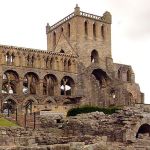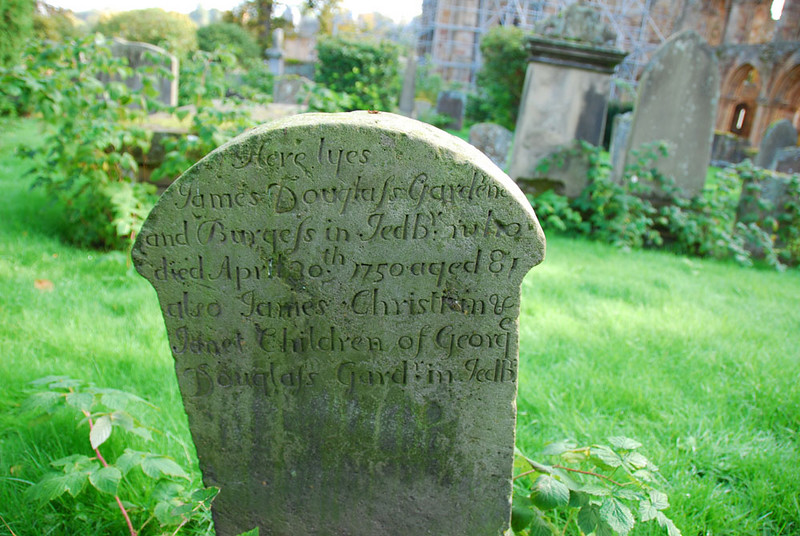Jedburgh Abbey
 Jedburgh
Abbey, a ruined Augustinian abbey which was founded in the 12th.
century is situated in the town of Jedburgh, in the Scottish Borders
just ten miles north of the border with England at Carter Bar.
Jedburgh
Abbey, a ruined Augustinian abbey which was founded in the 12th.
century is situated in the town of Jedburgh, in the Scottish Borders
just ten miles north of the border with England at Carter Bar.
Towards the middle of the 9th century, before the present border
between England and Scotland had been ascertained, there were two
Gedworths (as Jedburgh was then known). One of them became the
Jedburgh we know now, the other was four miles to the south.
According to Symeon of Durham, Ecgred, bishop of Lindisfarne from
830AD to 845AD, gifted the two villages of the same name to the See
of Lindisfarne. The southerly Gedworth was the place of Ecgred's
church, the first church in the parish. The present town was
distinguished from the long disappeared south village by UBI
CASTELLUM EST meaning, 'where the castle is'. The only solid
evidence of Ecgred's church came from Symeon of Durham when he
described the burial, at the church of Geddewerde, of Eadulf, one of
the assassins of William Walcher, Bishop of Durham.
In 1118,
prior to his ascension to the Scottish throne, Prince David
established a foundation of canons regular of the order of St.
Augustine at, what is now Jedburgh. The foundation appeared to have
the status of 'priory' in the early years and a man by the name of
Daniel was described as the Prior of Geddwrda in 1139. The church
was later raised to the status of monastery before becoming in the
years prior to King David's death in 1153 probably in 1147, a fully
fledged abbey and dedicated to the Virgin Mary. It has to be
mentioned that over the years, Jedburgh has been described by 83
different names or spellings.
After the death King David I of
Scotland, the patronage and priveleges of the abbey were accorded,
first by David's son, Prince Henry then by his grandsons Malcolm IV
of Scotland and William I of Scotland also known as William the
Lion. The nave and the choir were built in the 13th century and were
in place by the time Alexander III of Scotland married Yolande,
daughter of the Compte de Dreux in 1288 at the church. The great
abbey was said to contain the finery of the best of Norman and early
English Architecture. The Abbey Church of St. Mary of Jedeworth was
growing in stature and importance and the abbot was even invited to
attend Scottish Parliaments. As well as the lands and chapels in
southern Scotland, Jedburgh Abbey owned great lands in
Northumberland. In 1296, the Abbot of Jedburgh swore fealty to
Edward I of England at Berwick-on-Tweed. Edward intended to rule the
abbey and presented William de Jarum as the new Abbot of Jedburgh in
1296. After the defeat of the Earl of Surrey in 1297 at
Stirling at the hands of
William Wallace, the abbey was pillaged and wrecked by the English
as retribution. Robert I of Scotland (The Bruce) continued to
patronise the church during his reign in the early 14th century. In
1346, after the Scotish defeat at the
Battle of Neville's Cross,
the English once again slighted the church. Later that century, in
1370, David II of Scotland was instrumental in the completion of the
north transcept we can still see today. The abbey faced more torture
and destruction in 1410,1416 and by the Earl of Warwick in 1464. In
1523, the town and abbey were set ablaze by the Earl of Surrey. The
abbey faced more indignity in 1544 at the hands of the Earl of
Hertford. The end came for the great Abbey of St. Mary of Jedburgh
in 1560 and the coming of the Scottish Reformation.
Jedburgh
Grammar School was founded by the monks of Jedburgh Abbey in the
late 15th. century.
When the Protestant Reformation arrived
in 1560, the monks were allowed to stay but the abbey was used as
the parish kirk for the reformed religion. In 1671 the church was
removed to the western part of the nave for safety reasons. This
situation persisted until, in 1871, it was considered unsafe to
continue worship at the abbey church and a new parish church was
built. The Marquis of Lothian immediately started work on the
restoration of the great church but in 1917 the church dedicated to
St. Mary nearly 800 years earlier was handed over to the state and
is now in the care of Historic Scotland.
 James
Douglass c1669 Gardener and Burgess of Jedburgh. James married (1)
Isobell Couman/Cowman in 1703 in Jedburgh and (2) Jannet Olipher/Oliver
in 1710 in Jedburgh. Children found for James include George Douglas
1720 Gardener, Margret Douglas 1722 and James Douglas 1727. The
first three infant children of George Douglas 1720 Gardener and his
wife Agnes (Annie) Oliver 1723 - ie James (1) 1748, Christian (1)
1750 and Jannet 1752 are buried with James c1669 who lived till the
age of 81 and they are buried in the Jedburgh Abbey graveyard.
George and Annie had 12 children between 1748 and 1768 - including
John Douglas 1759 of Jedburgh Master Clockmaker
James
Douglass c1669 Gardener and Burgess of Jedburgh. James married (1)
Isobell Couman/Cowman in 1703 in Jedburgh and (2) Jannet Olipher/Oliver
in 1710 in Jedburgh. Children found for James include George Douglas
1720 Gardener, Margret Douglas 1722 and James Douglas 1727. The
first three infant children of George Douglas 1720 Gardener and his
wife Agnes (Annie) Oliver 1723 - ie James (1) 1748, Christian (1)
1750 and Jannet 1752 are buried with James c1669 who lived till the
age of 81 and they are buried in the Jedburgh Abbey graveyard.
George and Annie had 12 children between 1748 and 1768 - including
John Douglas 1759 of Jedburgh Master Clockmaker
Extracts from: Jedburgh Abbey : historical and descriptive :
also, The abbeys of Teviotdale, as showing the development of Gothic
architecture (1894) by James Watson, published in Edinburgh by David
Douglas
AFTEI: the hurning of the town hy the Earl of \Varwick in
1464, h.dburzh does hot appear to bave again suflircd at the hands
of the en«qay for fifty-nine years; but in 152:--ten ycars after
the battle of Fl,,ddcn--both town and al,bey suflred very sevérely
1,y thc Enulish uader the Earl of Surrey. (n the evcning of thc
22nd «»f S.l»tcmber , the enemy, to the numbcr of 6000 fighting
men, encaml»ed on the south side of the .led, and early next monling
thc town was storme(l. The burghers, who coul,1 command no m»re
than 1500 or 2000 men, ruade, nevérthcless, a me»st determined
resistance, and the English b»und it a hard task to become mastcrs
«»f the ilace. The abbey was also bravely dêfended, and ahhough
SuTey brought his cmmon to bear upon it, it did hot cal»itulate
till two hours after nightfall. The monastery was then 1,illaged and
committed to the flames, the effects of which are still visil,le on
various parts of the ruins. Surrey's testimony to the valour of the
Scottish Bordcrers at this rime was, that he found t],.m the ]»oh]est
mea and the hottest he ever saw in any nation.
It appears
from a charter gïanted by John, abbot of Jedburgh, and thc convent,
on 23rd l)ecember 1541, and afterwards confirmed ml,ler the Great
Seal, that \Villiam Douglas of ]h»njedward hnd c«,ntrihuted towards
the reparation of the monastery after this struction, and that in
return the said abbot and convent gave in feu-farm the lands of
Toftylaws and l'addohugh, in the barony of Houst(,un {Ulston), which
I)ouglas had held for nineteen years.
A respire, dated at i}umfries
on 28th August 1504, was anted by James IV. under the Privy Seal,
to a considerable nunber of persons, " lnen, kin, and tenants " of
Archl_,ishop Blackader of gow, for the slaughter of Thomas
l:uther[urd, COlnlnitted in the mr, nastery of Jedburgh (l'itcairn's
6'ri,ni«l 2'rials, Vol. II.). For the saine slaughter, a
remission, dated ai Edinburgh, 28th February 1506, was also granted
by the king to the saine parties, including ",lvhn Foreman of I}awane,
Baldred Blacater, knights ; John Twedy of Drumelzear, Alan Stewart,
Robert l:laeater, son and apparent heir of Andrew Blacater of that
Ilk; Adam Blacater, Charles Blacater, John Hergott, Adam Turnbull of
l'hillophaueh, William Turnbull, his son and apparent heir; {3eorge
Douglas of Bonjedburgh, ,lohn Douglas, his brother ; Andrew Douglas
in Tympanedene, l:obert Dougl, his brother," and others (J'd/erslot
l'tricots ). The respite, published by Pitcairn, alludes to
Archbishop Blackader as being « commendator" of the abbey. We have
no particulars as to the cause or circumstances of this occurrence.
In 1498, Robert Ker of Sonderlandhall sold his lands of
Esselieband to Sir William Douglas for 240 merks Scots, to be paid
"on one day between sunrise and sunset in the parish church of
Jedworcht, upon the altar of St Mary the Virn " (I[istory o.f ,%llirkshi'e,
by Mr Craig-Brown, Vol. II.).
In addition to the altarages
we have named there was an altar in the abbey dcdicated to St Ninian.
ç_)n llth (_)ctober 1503, at the altar of St Ninian, there was drawn
up a notarial instrument on the consimtion of Mr ;awin Douglas,
provost of St Giles Collcge (_'hurch, Edinburgh, as procurator for
George, Mastcr of Angus, Lord of Jcdworth Forest, into the hands of
])avid Douglas, burgess of .Iedworth, of the sure ,f 100 merks
Scots, to be kept for the profit of Ralph Ker of l'rimsydloch, to
whom the said Gawin had ofired it for the redemption of the lands
of Langlee and l;illistungis, in the lordship of Jedworth Forest,
but who wouh[ hOt resign the said lands, in respect that, as he
thought, the seven years' tack o the lands which he offered him, in
terres of the letters of rvision, was uot sut5cient. Among others
prcsent were Valter Scot of Buccleuch, knight, William Ker of Zare,
and Gorge Iouglas of Bonjedworth (D,,«glas JS'ook, Vol. III., pp.
180, 181). In 1576, when an account was taken of the thirds of
beneficcs, the third of the aharage of St h'inian in Jedburgh was
.£3, 4s. 5d.
Mr louglas, the minister (1758-68) (a time
when) the vaults at Al,l,otshall had I,eeli removed in 1748 by the
Laird of lloujedward, to whom they had heen s«,hl.
On the
death of Mr Winchester, minister of Jedburgh in 1755, a presentation
to the vacancy was obtained by the Marquess of Lothian from the
Crown in favour of Mr :Bonar, minister of Cockpen; but this was
resisted successfully by the Jedburgh Te»Wh Council, and
Mr Douglas,
Kenmore, got the living after much opposition. A strong party was in
favour -f Mr Boston being brought froid. Oxnam.. but the Marquess of
Lothian, who had the n,minati,m, though the Çrown was patron, wou]d
hOt hear of t. On the marquess presenting Mr loston to Oxuam he
promise«| to give him a better whenever it was in his power, and
when Crailing became vacant Mr Boston reminde«l his lordship of his
promise. The marquess infornmd him that the kirk in question had
been promised to a preceptor of the Lothian family long previous to
his settlement at Oxnam, but assured him that his 1,romise would be
remembered whenever he had the power to fulfil it. Mr loston, in a
letter which showed more bitterness than good taste, replied that
his lordship had "acted in this ail'air neither with the honouï of a
nobleman nor the faith of a Christian." This was why Lord Lothian
would hot nominate him for Jedburgh.
RENT ROLL OF THE ABBEY.
William Douglas of ]onjedburgh, for his lands of Toftilaw,
l',dopuill, and Spittlestains, worth 48 bolls vict.; payes £1,
13sh. 4d.
See also:


